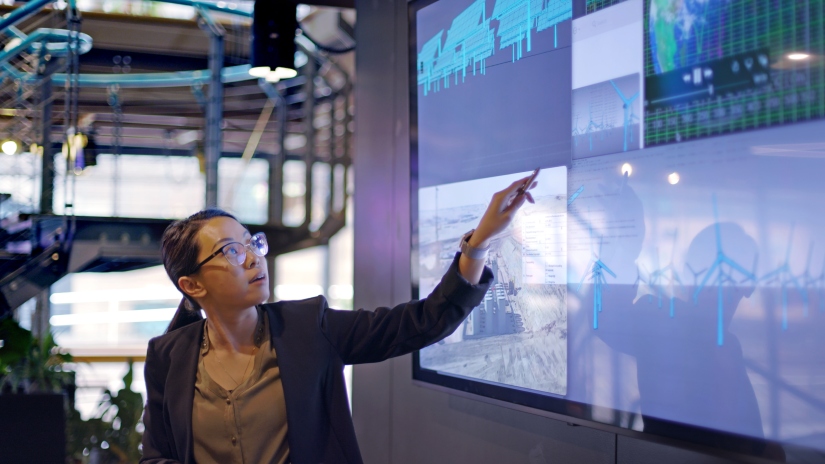By Kal Allam, Vice President & General Manager, Environment Business Division – North America, Hitachi, Ltd.
Around the world, organizations are recognizing the importance of sustainability to their business — not only in meeting global carbon emissions goals, but also as a key to their survival. However, the transition to becoming a sustainable business is not easy. The journey to becoming a truly sustainable business include addressing questions such as considering the potential costs and complex operational challenges of implementing sustainability programs, compliance with a variety of regulations and developing workforce readiness as new technologies are implemented. All these and other questions can cause companies to hesitate in adopting a focus on sustainability.
Like many businesses, Hitachi has set ambitious decarbonization goals, including the decarbonization of our buildings, factories and assets by 2030, and of our entire value chain by 2050. We recognize the challenges inherent in that commitment and have pivoted our business to focus fully on transforming into a more sustainable business.
Using our own company as a proving ground, we’re developing technologies, systems and processes for sustainable transformation that any business can use. One key example of our focus on sustainability is how we’ve organized our business to focus on three key areas: green business, digital business and innovation – three areas we believe are critical to the success of a green economy and a sustainable future.
In the United States, transportation and energy are two of the biggest contributors to greenhouse gases.1 To focus our activities in these sectors, we have created a Green Energy & Mobility division that encompasses our Hitachi Rail, Hitachi Energy, nuclear power and other energy divisions. Our investment in Hitachi Energy has positioned us as a key innovator in the creation of the core energy infrastructure that is essential for a sustainable, reliable and resilient grid. Additionally, our work with electric vehicle (EV) technologies, battery systems and other energy storage technologies is supporting the transition to electrification and a robust fleet infrastructure for sustainable transportation.

As new green technologies proliferate, the demand for a workforce skilled in implementing green technology will increase. For example, according to the U.S. Bureau of Labor Statistics, two occupations with the fastest projected employment growth from 2020 to 2030 are wind turbine service technicians (68% increase) and solar photovoltaic installers (52% increase).2 Hitachi is investing heavily in upskilling and reskilling initiatives and currently hosts multiple STEM and other technology apprenticeship programs across Hitachi companies. Our president and CEO, Keiji Kojima, also recently announced plans to hire 30,000 people skilled in digital transformation.3
We believe that a green economy will need a strong digital economy to succeed. Only digital technologies have the scale, speed and capabilities to meet the enormous demands and challenges of meeting the stated carbon emissions goals of countries around the world. Gathering, tracking, optimizing and integrating data; generating actionable insights; and optimizing physical and virtual systems and processes will all be essential to going green. Digital technologies such as AI, machine learning and automation are critical and necessary enablers for those goals. Organizations committing to sustainability will need to lean heavily on the development of digital capabilities to redesign legacy technologies and become more sustainable. Digital innovations such as automation and augmented reality technologies can also support the reskilling and retraining of the workforce that will be necessary for this transition.
Digital technologies also have another important role to play in helping companies monitor their investment in sustainability programs and the impact of those programs. With solutions that track, measure and optimize their Scope 1, 2 and 3 emissions, organizations can not only make a business case for their green initiatives, but they can also more fully understand the value that their sustainability initiatives can bring in the future. As a leading global digital technology innovator, Hitachi has developed multiple digital solutions across various industries that empower our customers to make better business decisions to reduce their carbon footprint. For example, the nation of the Faroe Islands is using Hitachi Energy’s e-meshTM PowerStoreTM battery energy storage system to help it meet its ambitious goal of moving 100% to sustainable energy by 2030. Another example is our high-voltage direct current (HVDC) technology which is being used in a new initiative to facilitate the sustainable transmission and distribution of reliable, clean and renewable power from hydroelectric sources in Canada to New York in the United States.

Meeting carbon reduction targets and reducing fossil fuel consumption to near zero will take tremendous shifts in how energy is produced and consumed. It will also require innovations sustained across industries, verticals, sectors and technologies, and all within a relatively short period — a couple of decades — if global climate goals are to be met. With our strong commitment to delivering innovative technologies that improve outcomes for people and the planet, Hitachi is a leading climate change innovator. For example, Hitachi Energy is enabling traditional power plants to generate and transmit energy from alternative and renewable sources, such as solar and wind.
Hitachi’s commitment to decarbonization across our organization encompasses more than 800 companies in sectors such as mining, transportation, manufacturing, energy and more. The innovations we are developing, testing and proving in our Hitachi Group companies can be used by companies around the world to support their own sustainability goals.
Partnerships between public entities and private organizations are making it easier for businesses to achieve their sustainability goals. For example, the U.S. federal government has passed several bills for that purpose in the last couple of years, including the Inflation Reduction Act (IRA), which commits more than $370 billion to green investments and to accelerate the transition to a clean energy economy.4 Businesses, institutions, state and local organizations, and tribal organizations can use the incentives, tax benefits and credits available from the IRA to lower their emissions footprints and reduce their energy costs.
When private companies partner with public agencies, as Hitachi did with Snohomish County Public Utility District (SnoPUD), a public utility in Washington state, the community can greatly benefit. Together, the two organizations built a next-generation microgrid that provides reliable power, uses vehicle-to-grid (V2G) power for resiliency and powers the utility’s operations on 100% renewable power. Such partnerships pave the way for other organizations to achieve sustainability goals that otherwise might be out of reach.
At Hitachi, we view our commitment to sustainability as a part of our core mission for our company, our customers and the planet. Learn more at Hitachi Sustainability.

Vice President & General Manager, Environment Business Division – North America, Hitachi, Ltd.
Mr. Allam is an executive leader with more than 20 years of experience spanning four continents with large global companies across multiple sectors including Energy/Infrastructure, Grid & Energy Storage, Digital industries, Enterprise Software, AI, & Cloud.
Mr. Allam joined Hitachi Energy (then ABB) in 2018, with responsibility for growing a portfolio of business for Utilities and Industries across Canada. In that role, he led sales, engineering and commercial operations teams to help customers modernize and maintain their grid infrastructure.
As General Manager of Hitachi’s Environment Business Division in North America, Kal is responsible for delivering growth across a portfolio of Hitachi’s environmental and sustainability solutions, by expanding markets, building new business models, and driving meaningful business and societal outcomes.
Prior to his role at Hitachi, Mr. Allam held key leadership roles at Cisco, GE Energy and Schneider Electric. He holds an MBA from the American University of Cairo, a Master of Science in Computer Science from the University of Louisville, Kentucky and a Bachelor of Science in Engineering from Ain Shams University, Egypt and is completing the Executive Leadership Program at Harvard Business School for Executive Education.